🎨 Cultivation Practices
Location, Site, Lay out, System of planting, Training, Nurseries
Location and Site selection of orchard
Location
👉🏻 Refers to geography of the field in relation to city, highway, town etc.
Site of orchard
- Place in relation to topography, altitude, water body and other factor which affect tree beavering.
- Factors affecting selection of site:
- Land slope: Should not be more than 5%. If slope more than 15% unsuitable for orchard.
- Direction of slope: Southern slope receives more sunshine hence produce early flowering so, early crop can be taken.
- Soil fertility:
- High fertility requiring crops: Mango, Citrus, Grape
- Poor fertile crops: Phalsa, Aonla
- Soil texture:
- Light texture for papaya and Ber.
Lay out of orchard
- It includes system of planting and planting distance.
System of planting
Square system
- Simplest and widely adopted/popular method
- In this method R x R and P x P distances are kept
similar. - The plants are planted exactly at
right angleat each corner. - Number of plants/ha = 10,000 m2/x2
- Where, x2 = R x R/P x P
Rectangular system
More plantscan be planted as compare to square system.- Keeping more space between row to row and plant to plant distance is kept comparatively less.
- Number of plants = 10,000 m2/X x Y.
Hexagonal or Equilateral Triangle System

- It accommodated
15% moreplants than square system. - The plants are planted at the corner of equilateral triangle.
- This is very intense method of planting and difficult to layout.
- Requires fertile land.
Quincunx system/diagonal/filler system
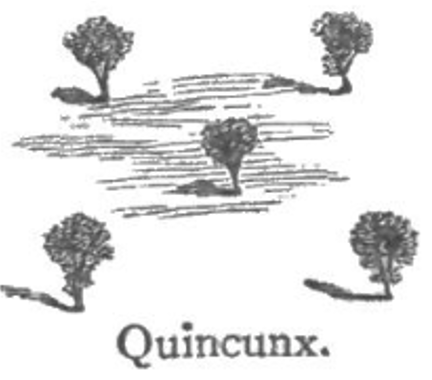
- Most suitable in highly fertile soil.
- This method is similar to square system but an additional
filler plantis planted in the center of square. - It accommodates
1.5 times more plantthan square system adopted only when tree spacing exceeds 8 m or fruit crop which are very slow growing in habit. - The most common filler plants are papaya, kinnow, phalsa, guava, peach, plum etc.
- Filler plants give additional income for non-bearing orchard.
Contour (Terrace) system

- Suitable for hills and undulated lands.
- Planting distance is not uniform.
- Bench terrace is popular in hills.
Triangular system
- In this system, trees are planted as in the square system but the plants in the 2nd, 4th, 6th and such other alternate rows are planted midway between the 1st, 3rd, 5th and such other alternative rows. This system provides more open space for the trees and for intercrop.
- It is mostly used in
HDP(High Density Planting). - E.g. Amrapali variety of mango.
Intercropping
- Suitable plants for intercrops in orchard:

Pruning
- Removal of any excess or undesirable/ unproductive branches, shoots or any other parts of plants so as to allow the remaining part to grow normally or according to desire of pruner is called pruning. NABARD 2021
- It improves the shape of plant, influences the growth behavior, flowering time and fruitfulness, besides improving the quality of fruit.
- Pruning is started in later part of plant life when becomes produce fruits and flowers.
- Pruning time in north India:
April – May.
Method of pruning
Thinning Out
- This refers to the removal of the branches entirely from its base leaving no stubs.
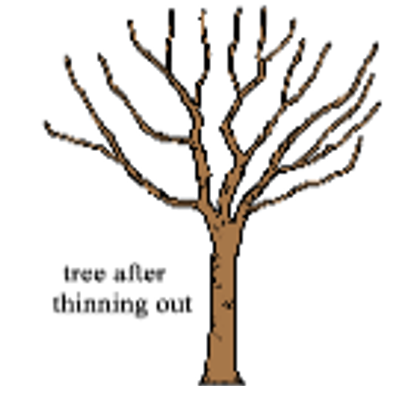
Heading Back
- This refers to pruning or cutting of terminal part of main stem or all or few of the branches leaving a basal portion.
- This method is often followed for hedges, ornamental shrubs, first dormant pruning and October pruning in grapes.
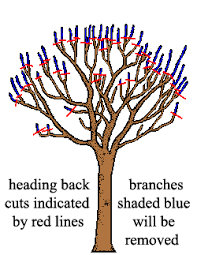
Ringing/ Girdling
- In this method a circular ring measuring about 3 cm in length is removed to hasten bearing by allowing greater accumulation of photosynthesis in upward portion of the plant.
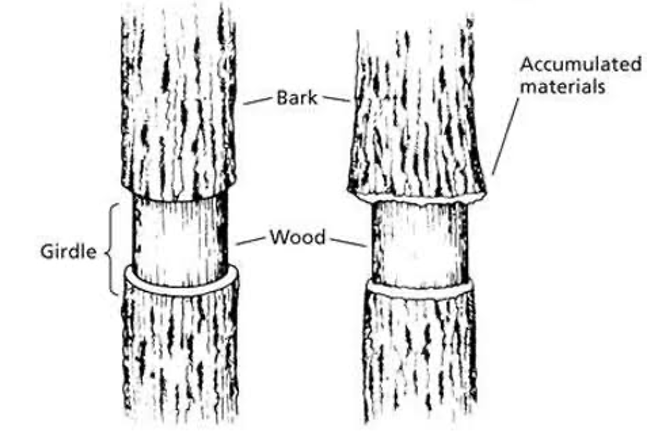
- This is important practiced is done in
grapes.
Notching

- Making a notch above a bud by removing a wedge-shaped piece of bark is termed as notching
- It checks the influence of hormone and encourages growth
- Notching is commonly practiced done in
Fig.
Disbudding or Rubbing off
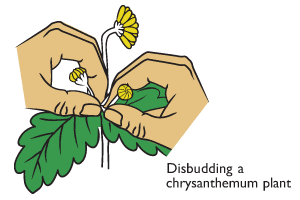
- Here the young buds are nipped without giving them the chance to sprout.
- The buds may be either Vegetative or reproductive.
- This is practiced regularly in flowering plants to make the terminal bud to give a bigger flower.
Pinching and Topping
- This refers to the removal of the tip of the shoot alone with a view to stimulate mildly the lateral growth.
- This is practiced regularly in coffee to remove the apical dominance and to allow the side brandies to grow vigouresely.
- E.g. Deshi cotton.

Top Working
- It is a technique or method of rejuvenation where in the objective is to upgrade seedling plantations of inferior varieties with superior commercial cultivars or hybrids suitable for domestic or export market or the desired variety of the grower. Eg Cashew tree.
- The technique involves
graftingwith procured scions of desired variety on shoots emerged on pruned branches by adoptingTongue graftingduring monsoon season. (Season of top working slightly varies from species as it also depends on availability of good shoot and scions). - The scion shoots and the emerged shoots should be of same thickness.
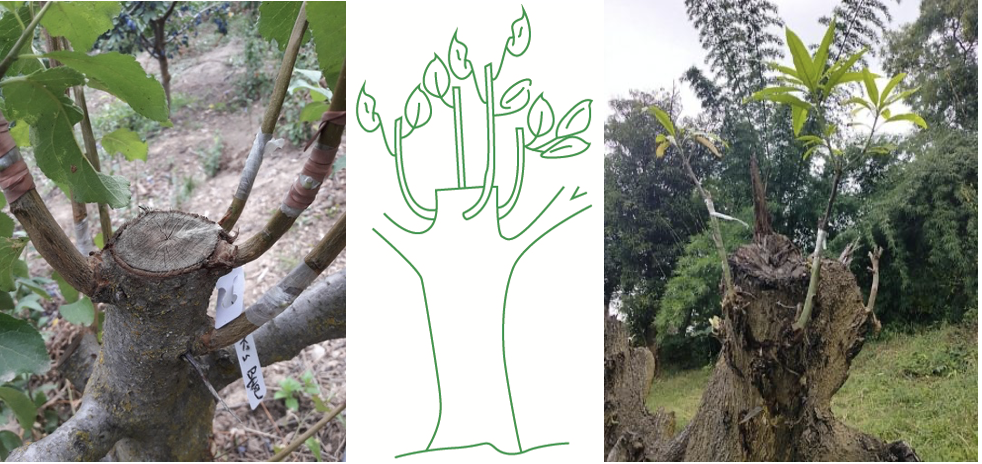
Types of Pruning
👉🏻 Pruning can be divided into two based on the seasons in which it is done:
Dormant Pruning
- Most often done during the
winter- commonly referred to as dormant pruning. - Dormant pruning is an invigorating (enerziging) process.
- Heavy dormant pruning also promotes excessive vegetative vigor.
- Timing of dormant pruning is critical. Pruning should begin as late in the winter as possible to avoid winter injury.
Summer Pruning
- Done during
summers- referred to as summer pruning. - It’s severity is much less, less common, more specific and selective.
- Eliminates an energy or food producing portion of the tree and results in reduced tree growth.
- For most purposes, summer pruning should be limited to removing the upright and vigorous current season’s growth; only thin cuts should be used.
- To minimize the potential for winter injury, summer pruning should not be done after the end of July.
Pruning based on height

Technique of training and their timings
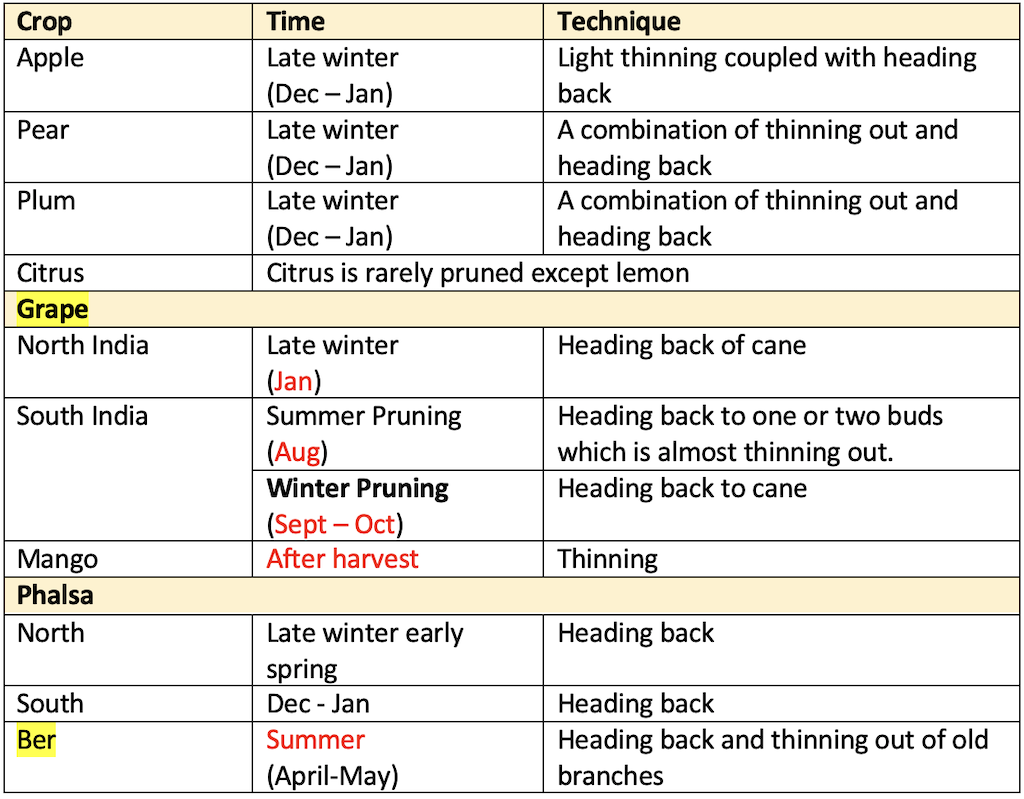
Training
- Training is a practice in which tree
growth is directed into a desired shape and form. - Judicious removal of plant parts to develop a proper shape of plant capable of bearing heavy crop load.
- It is done from earlier part of plant life.
- It determines the general character and even details of the plants outline and of its branching and framework.
Objectives of Training
- To admit more sunlight and air to the centre of the tree and to expose maximum leaf surface to the sunlight.
- To direct the growth of the tree so that various cultural operations, such as spraying, and harvesting are performed at the lowest cost
- To protect the tree from sunburn and wind damage.
- To secure a balanced distribution of fruit-bearing parts on the main limbs of the plant.
Principle of Training
- The principle objective in training a young tree is to develop strong framework of scaffold branches.
- All methods of training must stand or fall by their ability to achieve a tree capable of bearing high yielding fruits without undue breakage.
Types of Training Systems
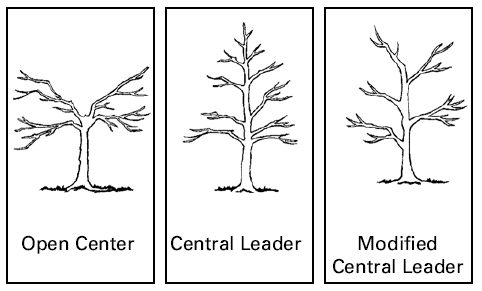
Central Leader System
- Main trunk extends from the soil surface to the total height of the tree.
- Several side branches grow at different heights in various directions. They are usually lower in vigour and productivity.
- This system of training is adopted such types of trees which have a pronounced apical dominance.
- On account of vigorous and rapid growth of the main trunk the tree develops a close center and grows to great heights.
- Since the plants would be very tall, the spraying and harvesting operation becomes difficult and costly e.g. pear and some varieties of apple.
✅ Advantages
- Such trees are structurally best suited to bear crop load and to resist the damage from strong winds.
❌ Disadvantages
- Trees under this system grow too tall and are less spreading.
- Tree management (spraying, pruning, thinning and harvesting) is difficult.
- This method not suitable for high altitude and hot arid places where wind velocity is high.
- Shading effect on interior canopy (the lower branches of such trees may be so much in shade that the fruit may not be able to develop proper colour).
Open Centre System
- In this system, the main trunk (main stem) is allowed to grow only up to a certain height (upto 1 m) by cutting within a year of planting and all the subsequent vegetative growth promoted by lateral branches.
- This results in a low head and as such the bulk of crop is borne closer to the ground.
✅ Advantages
- The trees so trained allow maximum sunshine to reach their branches.
- Better coloration of fruits on the interior side of the tree.
- Trees are more fruitful and low spreading tree greatly facilitate operations like spraying, pruning, thinning and harvesting.
❌ Disadvantages
- Such trees are structurally weak, and their limbs are more likely to break with crop load and strong winds.
- Not suitable for frost prone area.
- This system does not only need severe pruning to start with but also constant effort to maintain its form through drastic pruning treatment.
Modified Leader System
- This system stands intermediate between the central leader and the open center, combining the advantages of both the system.
- It is developed first by training the tree to the leader type allowing the central stem to grow unsharpened for first four to five years.
- The main branches are allowed to arise on the main stem at reasonable intervals. After the required number of branches has arisen the main stem is cut off.
- Most widely adopted method for fruit crops.
- The top laterals will take the place of the main stem. The result in a fairly strong and moderately spreading type of tress. E.g. Pear, Apple, Walnuts, etc.
✅ Advantages
- The branches are well distributed, allowing plenty of sunshine to reach the interior of the tree.
- The trees are structurally strong and not prone to limb breakage.
- This is most acceptable for commercial fruit production.
Tools
Secateur

- Pruning shears, also called hand pruners (in American English), or secateurs (in British English), are a type of scissors for use on plants.
- They are strong enough to prune hard branches of trees and woody shrubs, sometimes up to two centimetres thick.
- They are used in gardening, arboriculture, plant nursery works, farming, flower arranging, and nature conservation, where fine-scale habitat management is required.
Hedge Shear
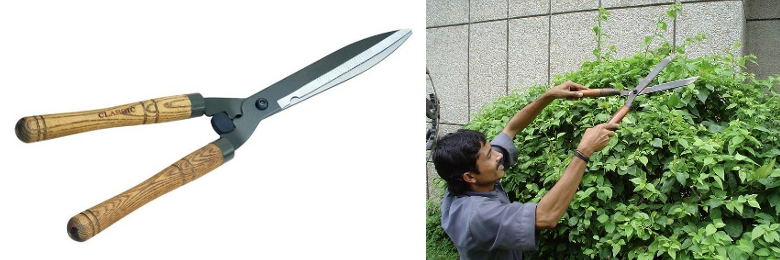
- A hedge trimmer, shrub trimmer, or bush trimmer is a gardening tool or machine used for trimming (cutting, pruning) hedges or solitary shrubs (bushes).
Bill Hook
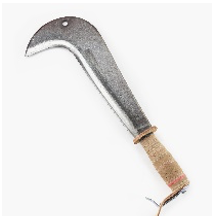
- It is used to cut the hard branches and Woody shrubs of plants. RRB-SO-2020
Grafting Knife

Trowel

Nurseries
👉🏻 Nursery is place where young crop plants are raised under intensive care for later transplanting to the field.
Classification
- On the basis of irrigation facilities
- Dry Nursery
- We Nursery
- Temporary Nursery: Flying Nursery
- Permanent Nursery
- On the basis of size of production
- Commercial Nursery
- Small Scale Nursery
- On the basis of kind of plant material raised
- Fruit nursery
- Vegetable nursery
- Flowering plant nursery
- Forest Nursery
- Irrigation Methods in Nursery
- Flow or flood irrigation
- Furrow irrigation
- Overhead irrigation
- Rose canes
- Automizer
- Sprinkler System
- Water
- The water for nursery should have pH between 5.5 to 7.5 and contain salt less than 400 ppm.
- Amount of water required for raising one lakh plants in dry areas during summer is 20-30 cc/plant/day and during winter is 10 cc/plant/day.
Location and Site selection of orchard
Location
👉🏻 Refers to geography of the field in relation to city, highway, town etc.
Site of orchard
- Place in relation to topography, altitude, water body and other factor which affect tree beavering.
- Factors affecting selection of site:
- Land slope: Should not be more than 5%. If slope more than 15% unsuitable for orchard.
- Direction of slope: Southern slope receives more sunshine hence produce early flowering so, early crop can be taken.
- Soil fertility:
- High fertility requiring crops: Mango, Citrus, Grape
- Poor fertile crops: Phalsa, Aonla
- Soil texture:
- Light texture for papaya and Ber.
Lay out of orchard
- It includes system of planting and planting distance.
System of planting
Square system
- Simplest and widely adopted/popular method
- In …
Become Successful With AgriDots
Learn the essential skills for getting a seat in the Exam with
🦄 You are a pro member!
Only use this page if purchasing a gift or enterprise account
Plan
Rs
- Unlimited access to PRO courses
- Quizzes with hand-picked meme prizes
- Invite to private Discord chat
- Free Sticker emailed
Lifetime
Rs
1,499
once
- All PRO-tier benefits
- Single payment, lifetime access
- 4,200 bonus xp points
- Next Level
T-shirt shipped worldwide

Yo! You just found a 20% discount using 👉 EASTEREGG

High-quality fitted cotton shirt produced by Next Level Apparel